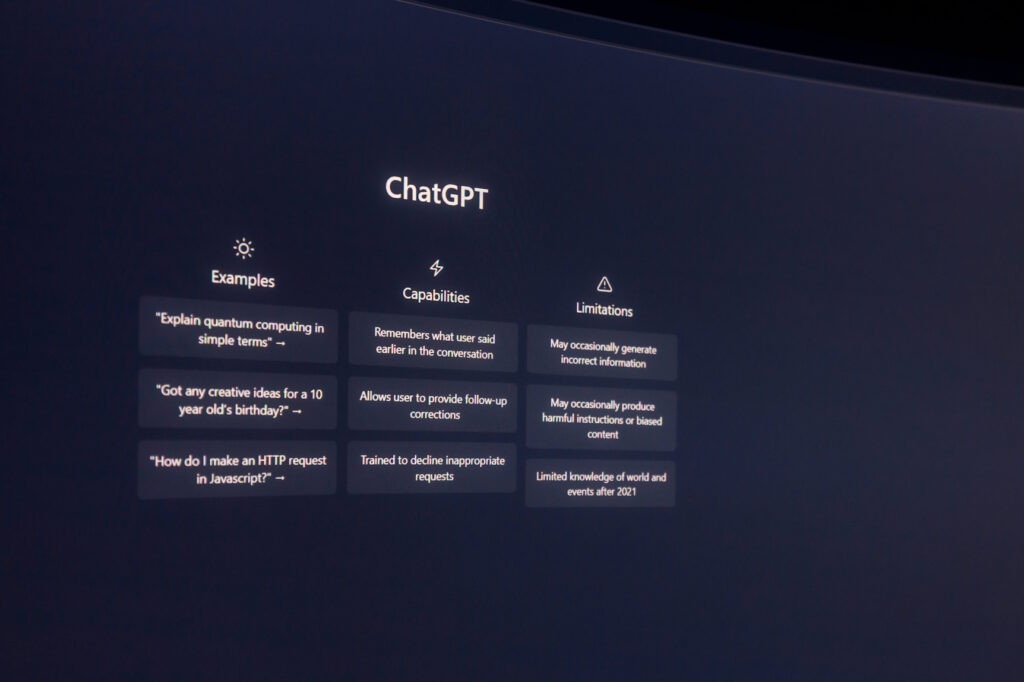AI in Insurance - Article 1 - A Catalyst for Innovation
How insurance companies can use the latest AI developments to innovate their operations
The emergence of AI
The insurance industry is undergoing a profound transformation driven by the relentless advance of artificial intelligence (AI) and other disruptive technologies. A significant change in business thinking is gaining pace and Applied AI is being recognised for its potential in driving top-line growth and not merely a cost-cutting tool.
The adoption of AI is poised to reshape the insurance industry, enhancing operational efficiencies, improving decision-making, anticipating challenges, delivering innovative solutions, and transforming customer experiences.
This shift from data-driven to AI-driven operations is bringing about a paradigm shift in how insurance companies collect, analyse, and utilise data to make informed decisions and enhance customer experiences. By analysing vast amounts of data, including historical claims records, market forces, and external factors (global events like hurricanes, and regional conflicts), AI can assess risk with speed and accuracy to provide insurance companies a view of their state of play in the market.
Data vs AI approaches
This data-driven approach has enabled insurance companies to improve their underwriting accuracy, optimise pricing models, and tailor products to specific customer needs. However, the limitations of traditional data analytics methods have become increasingly apparent in recent years.
These methods often struggle to capture the complex relationships and hidden patterns within large datasets. They are also slow to adapt to rapidly-changing market conditions and emerging risks. As a result, insurance companies are increasingly turning to AI to unlock the full potential of their data and drive innovation across the industry.
AI algorithms, powered by machine learning and deep learning techniques, can process vast amounts of data far more efficiently and accurately than traditional methods. They can connect disparate datasets, identify subtle patterns, correlations & anomalies that would be difficult or impossible to detect with human analysis.
By leveraging AI, insurance companies can gain deeper insights into customer behaviour, risk factors, and market trends. This enables them to make more informed decisions about underwriting, pricing, product development, and customer service and gain a competitive edge in the ever-evolving marketplace.

Top 5 opportunities
1. Enhanced Risk Assessment
AI algorithms can analyse a broader range of data sources, including social media posts and weather patterns, to provide more accurate risk assessments. This can lead to better pricing and reduced losses.
2. Personalised Customer Experiences
AI can create personalised customer experiences, from tailored product recommendations to proactive risk mitigation guidance. This can boost customer satisfaction and loyalty.
3. Automated Claims Processing
AI can automate routine claims processing tasks, for example, by reviewing claims documentation and providing investigation recommendations, thus reducing manual efforts and improving efficiency. This can lead to faster claims settlements and lower operating costs.
4. Fraud Detection and Prevention
AI algorithms can identify anomalies and patterns in claims data to detect and prevent fraudulent activities. This can protect insurance companies from financial losses and reputational damage.
5. Predictive Analytics
AI can be used to anticipate future events, such as customer churn or potential fraud. This enables insurance companies to take proactive measures to prevent negative outcomes.
Adopting AI in Insurance
The adoption of AI in the insurance industry is not without its challenges. Insurance companies must address concerns about data quality, data privacy, transparency, and potential biases in AI algorithms. They must also ensure that AI is integrated seamlessly into their existing systems and processes.
Despite these challenges, AI presents immense opportunities. Insurance companies that embrace AI-driven operations will be well-positioned to gain a competitive edge, enhance customer experiences, and navigate the ever-changing risk landscape.
The shift from data-driven to AI-driven operations is a transformative force in the insurance industry. AI is not just a tool for analysing data; it is a catalyst for innovation and a driver of change. Insurance companies that harness the power of AI will be at the forefront of this transformation, shaping the future of insurance and delivering exceptional value to their customers.
Download the PDF article here.
Séverine Raymond Soulier's Interview with Leading Point
Séverine Raymond Soulier’s Interview with Leading Point
Séverine Raymond Soulier is the recently appointed Head of EMEA at Symphony.com – the secure, cloud-based, communication and content sharing platform. Séverine has over a decade of experience within the Investment Banking sector and following 9 years with Thomson Reuters (now Refinitiv) where she was heading the Investment and Advisory division for EMEA leading a team of senior market development managers in charge of the Investing and Advisory revenue across the region. Séverine brings a wealth of experience and expertise to Leading Point, helping expand its product portfolio and its reach across international markets.
Scaling a cyber-security FinTech with our interim COO leadership
"Leading Point have been instrumental in helping us cover our COO needs at a critical stage for the business from a product readiness and a go-to-market perspective. They have developed our client implementation capability with fit-for-purpose processes, systems and methodologies, significantly improving our engagement with our target customers and our time to market. We look forward to our continued alliance with Leading Point as our implementation partner to help us grow in the right way."
CEO @ Information & Cyber Risk Startup
Innovation is Not Perfect. Accept and Embrace It
 Thushan Kumaraswamy
Thushan Kumaraswamy
Partner at Leading Point Financial Markets
It was my pleasure to attend Societe Generale's breakfast event on 9 November 2018 called "Implementing New Technologies" in Spitalfields, London on behalf of Leading Point Financial Markets. The event comprised of presentations about the FinTech innovation landscape and the use of Robotics Process Automation (RPA) in SocGen, followed by a panel discussion, hosted by Susanne Chishti, Founder of FinTech Circle.
Since there was so much good content and thinking at this event, I thought I would share my views on the event and how it ties to our propositions at Leading Point Financial Markets.
Do not ignore FinTech companies that are not 100% ready
There are thousands of FinTech (and RegTech, LegalTech, WealthTech, InsureTech, XYZTech!) companies just in the UK, let alone globally. Many of these are in different stages of their evolution.

Source: The Startup Lifecycle
Financial services firms, especially larger firms, often resist adopting innovative technologies from companies who don't have a long record of existing clients. In such a fast-moving environment as FinTechs, this can mean losing out on the potential business benefits at a time when competition is squeezing margins and ever-increasing regulatory pressures are driving up costs.
Imagine being able to run a pilot or proof-of-concept for a small area of the business, with an identified strategy of goals and specific objectives, to demonstrate to the senior management team how such a new technology could be used to deliver real business benefits. This kind of pilot can be run in an agile fashion, but require business and IT teams are fully on-board and involved with the project. Since the scope is small, the resource commitment is also smaller than a normal implementation.
There is a significant opportunity for financial services firms who are willing to start these small-scale projects with innovation companies who might not be 100% ready (in the Validating or Scaling phases above) alongside implementation partners who know the technology, have the domain knowledge and understand operating models.
Don't automate a bad process
Robotics Process Automation (RPA) as a concept is easy enough to understand; computer programs (the "robots" or "bots"), using a set of pre-defined rules replicate what humans would do using computer systems in a repetitive fashion. For example, daily copying of client names from an Excel sheet to a CRM (Customer Relationship Management) system. This basic automation can free up the human workers to do more valuable work.

Source: Robots Join The Team
This is all good stuff. However, before jumping straight to implementing RPA solutions, it is worth considering what the business process is actually doing. Is this Excel-to-CRM method the best way of getting client details into the CRM system? Is it possible to improve the process first? As part of an RPA implementation, you should be looking at process improvement strategies first, then automating what is left. This way, you save on the number of bots you would need and increase the efficiency of the process as a bonus. Process experts can document existing processes and identify opportunities for improvement prior to any RPA technology implementation.
How does a bot change a password when accessing a core system?
There are some potential gotchas when using bots, like the above question, which can cause problems during day-to-day running. If a bot uses a specific login to access a core system and that login has a password expiry, what happens then? Is the bot expected to define a new password? Should a human get involved? Also, consider licences on existing software platforms; are there any clauses that prevent the use of bots? There may not be right now, but it is not difficult to foresee software companies bringing in new clauses to control the potential uptick of system usage through bots.
Panel Discussion: Selecting and Implementing New Technologies

- Susanne Chishti, Founder of FinTech Circle (Host)
- Anthony Woolley, Head of Innovation, Societe Generale
- Vasu Vasudevan, Digital Enablement Capbility Lead, Schroders
- Richard Archer, Director, EY
- Keith Phillips, Executive Director, The Investment Association and Velocity
The first question was about trends in innovation. The guests talked about the bleed of innovation between FinTechs, RegTechs, LegalTechs, but also into manufacturing and other industry sectors. The biggest topics being:
- Artifical Intelligence (AI) and Machine Learning (ML)
- Big Data
- Cloud
- Distributed Ledger Technology (DLT) / Blockchain
- Social & Mobile
- Robotics & Automation
As mentioned above, the twin drivers of competition shrinking margins and regulatory compliance increasing costs are forcing companies to come up with new ways of thinking. This may not come naturally to the larger, older financial services firms. They may have pockets of innovation but sometimes struggle to create a company-wide innovation culture.

The importance of customer-centricity was raised to a question on technological advancements. Building a single view of client will enable improved service to clients and increased revenue growth using data analysis across large cross-referenced data sets to be more specific with marketing and cross-selling.
An interesting question about how to bridge the gap between legacy platforms and new innovations was put to the panel next. It was noted that capacity is required to do this. How do companies get that capacity? By using technologies like RPA to free up people to generate this real value for the business.
Another technique is to use APIs (Application Programming Interfaces) as wrappers around your legacy platforms to make them easier to connect to other, more modern, applications. Using APIs turns your legacy platforms into building blocks that be linked together. A COBOL API can let other systems use the data held in the COBOL system, without the need for expensive COBOL programmers.

Source: Intro to APIs
This brings additional data protection concerns though, as customer data held in these legacy platforms may not have up-to-date data security and data protection applied to them and exposing the data through APIs could potentially increase risk of data loss.
A concern raised by the panel was about the use of RPA as a concrete sticking plaster rather than as a purely temporary fix for the use of legacy technology. The temptation is there once an RPA solution is doing its work, to leave it there rather than address the legacy platform.
The panel were asked about their top three technologies. The answers covered:
- Data aggregation, clustering & consolidation
- AI and ML
- Blockchain
- Data analytics (behavioural analysis for active asset management)
- Digital passports (recording clients' digital identities)
- Intelligent automation (robotics)
- Unstructured to structured data
- Document intelligence (text mining)
- RPA
- Collaboration tools in investment operations
- Natural language processing (voice recognition)
- Cloud (along with data and APIs)

Source: Top 30 Emerging Technologies
One important factor for digital was considering how people interacted with their devices. Many people of a certain age feel comfortable using on-screen keyboards and touch gestures. Some younger people prefer voice interactions through assistants like Alexa, Siri or Google and that audience is only going to grow.
A vital question was put to the panel about how to implement new technologies. FinTechs often feel like they are in a zoo. Potential clients come to see what they can do, have some meetings, but then don't connect again. There are some activities that can improve the relationship-building on both sides for FinTechs trying to scale-up or break into financial services; along with the obvious (but not always followed) things like respecting each other and being collaborative, there is a need to not destroy the start-up's spirit. Go in to the relationship with the understanding that the technology partner is young and may need some support and guidance.
The idea of changing the culture of the financial services firms was discussed. It was believed that this needed both top-down leadership & funding and also bottom-up drive. An internal innovation fund was set up that enabled small teams working on-the-ground to prepare a business case and pitch over six months to present. Over 70 of these teams took up the challenge, with some generating real business benefits. But, it is more than those end success stories that matter; it is the change in mindset across the company that demonstrates that innovating is part of business-as-usual for everyone in the firm, not just a select few tucked away in an innovation lab.
Other key factors were having both business and IT teams engaged and willing to work together as partners, being able to run projects in an agile (or Agile) fashion and accepting projects that "fail fast", but test and learn quickly. It was interesting to see how business architecture could help in these situations by mapping commonalities across the business using capability models and describing roadmaps aligned to customer journeys.

Source: Practical Business Design
One of the major blockers to building an innovation culture was the procurement process in many large financial services firms. These bureaucratic processes can take over eight months to allow a start-up to being implementing a solution, which can destroy the innovation impetus. A fast-track procurement process, enabling implementation of new technologies, perhaps in some protected sandbox environment, taking eight weeks would be a massive enabler. It feels like there is work required to develop streamlined procurement processes, specifically for innovation technologies.
An audience member asked how many start-ups typically fail. In any typical innovation portfolio, an angel investor may have invested in ten start-up companies. Five of these will likely go bust. Three may remain as the "living dead", where they plod along, just existing as a private company, without any hope of getting a return on the investment. The other two may become "superstars", where they go public with a bang and these two pay off the investment in the other eight start-ups.
I believe that, with more help in providing a consistent analysis of these start-ups on behalf of private equity firms and venture capitalists, the ratio of failures:living dead:superstars could be improved.
This was a very interesting panel discussion and my thanks go to Societe Generale for running the event, the guest speakers on the panel & presenting and to Susanne Chishti for hosting. The themes of technological innovations and the challenges of implementing them in financial services were very familiar to what I have seen in my own experience, but these challenges are not insurmountable with the right support.
If you don't use these new innovations in your business, for example in the field of anti-financial crime, where do you think the criminals are going to go when your competitors
do use them?
Final thought: You cannot wait for the perfect innovation. By the time that happens, your competition may be far ahead of you. You would be better off using what innovation can offer now, but work together with the technology companies to complete that picture for your business.
The right partner can help intersect the old world with the new.
#innovation #event #socgen #data #technology #startup #scaleup #financialservices #ai #ml #rpa #robotics #blockchain #bigdata #cloud #fintech #regtech #legaltech #wealthtech #insuretech #implementingnewtechnologies #leadingpointfinancialmarkets #leadingpointfm #lpfm




